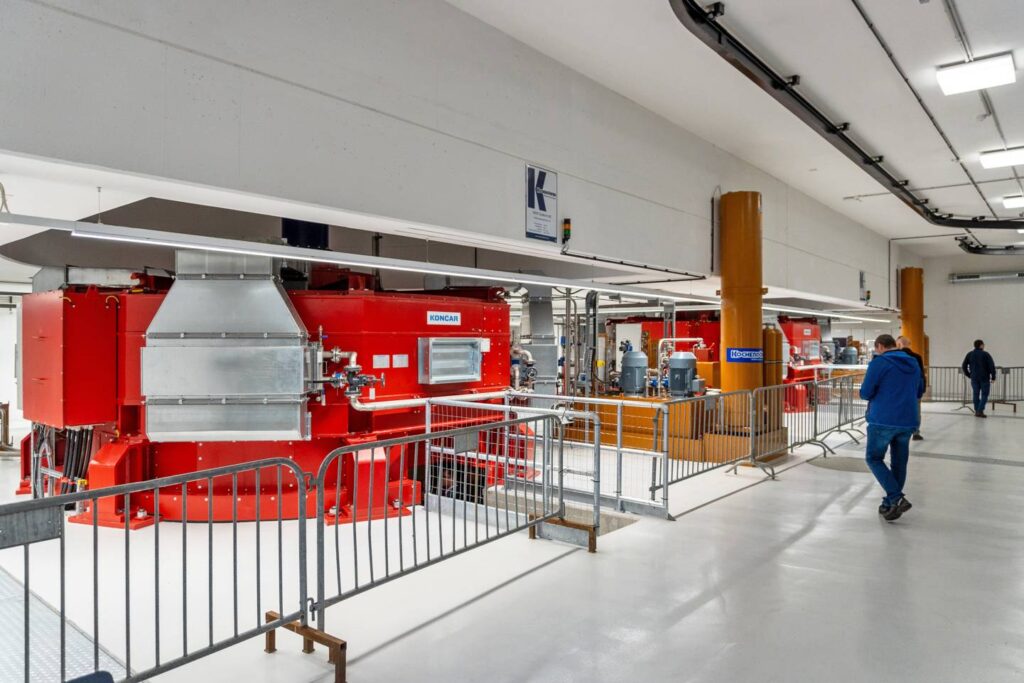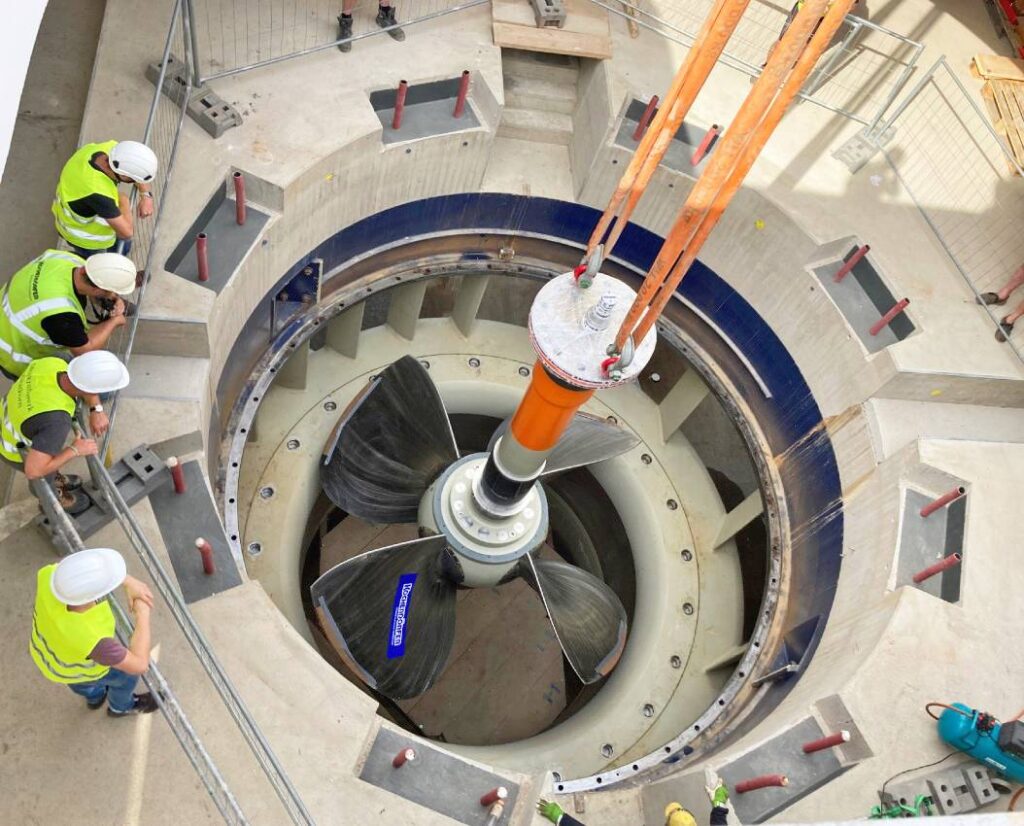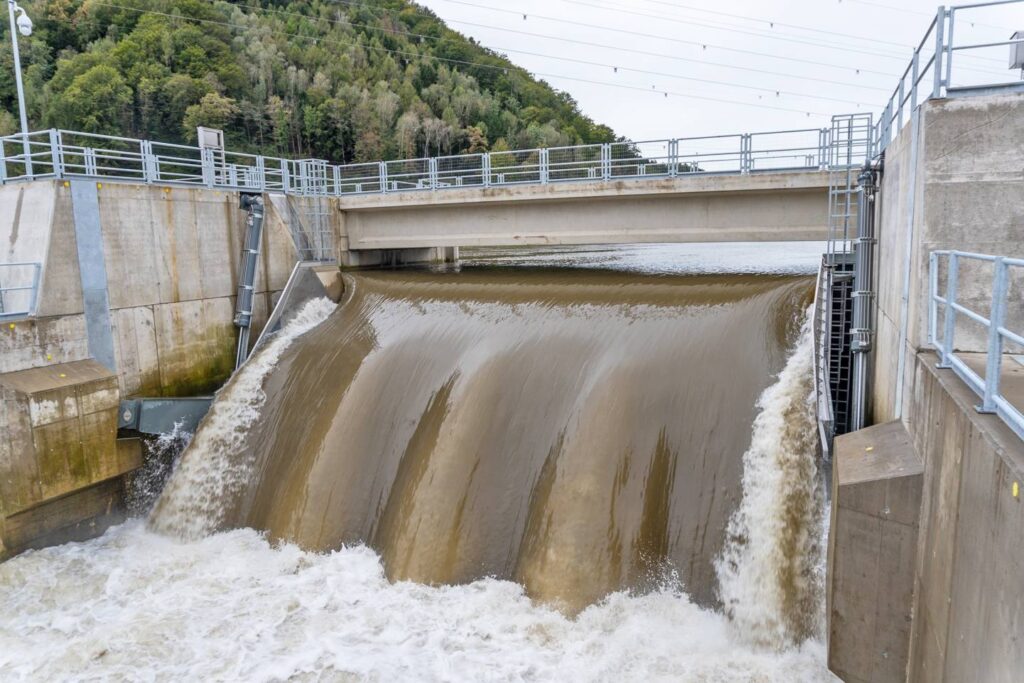New Gratkorn hydroplant supplies 15,000 housholds with 100% green electricity
Last October the new Gratkorn Mur power plant was officially opened by VERBUND and Energie Steiermark, around two and a half years after the official ground-breaking ceremony. The joint project partners built the plant around 10 kilometres north of the centre of the city of Graz to provide sustainably generated electricity to cover 100 percent of energy demands of around 15,000 households in an average year. Two Kaplan turbines were designed to accommodate a discharge flow of 205m³/s from a head of 6.62 metres, and to achieve a maximum power output in excess of 11 megawatts at full-capacity intake. When speaking at the commissioning ceremony for the green electricity project on the River Mur, having cost them around 100 million euros VERBUND and Energie Steiermark were delighted with the results.
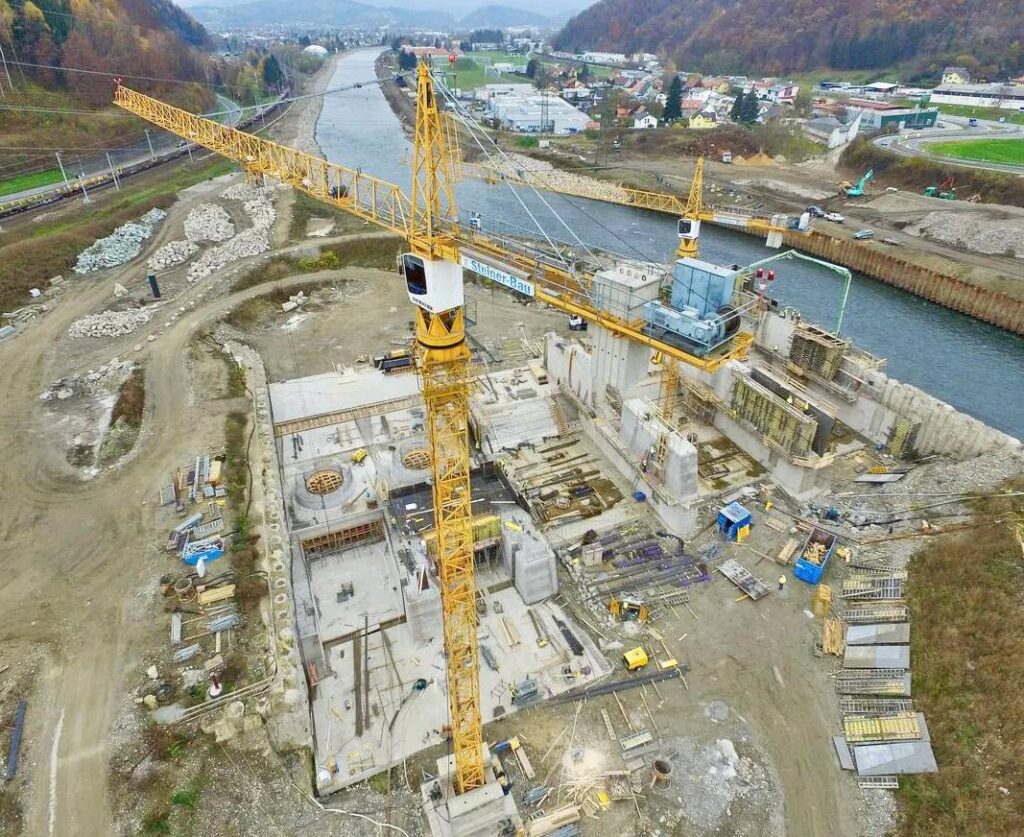
© VERBUND
Turbine 1 was turned on for the first time at the end of the construction phase in May 2024. Official commissioning of the new Mur power plant took place on 4th October. High-ranking politicians were joined in Gratkorn in Styria by numerous representatives of the project partners VERBUND AG and Energie Steiermark, and by representatives of various companies involved significantly in the realisation of the run-of-river power plant. In his speech, the former provincial governor Christoph Drexler described the new Mur power plant as a quantum leap for the energy transition in Styria. Michael Strugl, CEO of VERBUND, agreed, referring to an excellent partnership with Energie Steiermark: “We are working at full speed to transform our energy systems. Here in Styria in particular, hydropower plays a key role in renewable energy supply, and the commissioning of the Gratkorn Mur power plant is another building block towards a climate-neutral energy future.”

© VERBUND
All good things take time
According to David Oberlerchner, VERBUND project manager for the plant, the first plans for the construction of a run-of-river power plant on the Mur were developed over 40 years ago: “In 1981, as part of a phased plan, Austria’s water bodies were assessed in terms of their hydro-energetic potential, resulting in the first drafts for the construction of a new Mur power plant at the Gratkorn site. However, it took more than four decades from the initial plan to the official ground-breaking ceremony for the project partners VERBUND and Energie Steiermark. There were several reasons for this, Oberlerchner explains, but it was primarily due to the economic viability of the project – one that ultimately required an investment of around 100 million euros. Moreover, there were concerns among the local population that the construction of the power plant could affect the local drinking water supply. In Gratkorn demand is primarily covered by a municipal well. “Even though regional water deterioration resulting from a new power plant was extremely unlikely, obviously, the concerns and arguments of the citizens had to be taken seriously,” the project manager emphasised. Consequently, structural precautions were taken to guarantee the municipal drinking water supply and facilitate the connection to a drinking water pipeline running through the municipality.
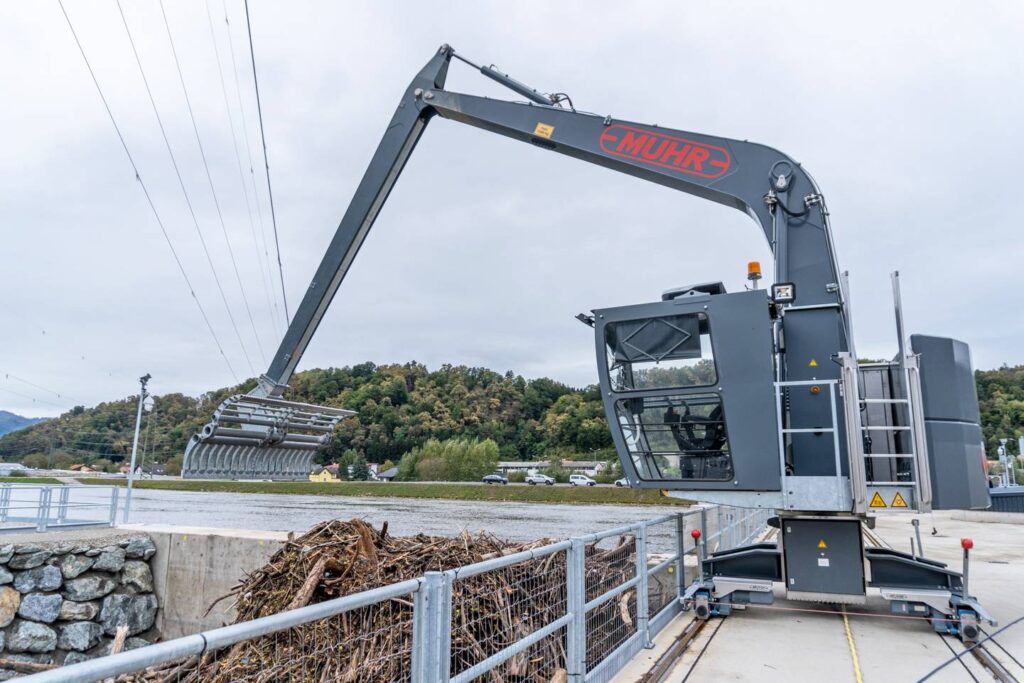
© zek
Bavarian industry experts ensure free flow
The basic structural and technical concept of the new power plant in Gratkorn was consciously modelled on existing plants along the Middle Mur. The new Mur power plant also utilises a three-field weir system. The adjacent powerhouse was fitted with two machine sets and located in Gratkorn on the orographic right-hand side of the river. Each weir field was equipped with hydraulically operated segment gates with flaps attached, each field at a total height of 8 metres and a width of 13.5 metres. Two vertical protective rakes at the intake area next to the weir system prevent larger debris from entering the headrace, while other floating debris is removed by a screen cleaning machine made by Muhr – Bavarian hydro-industry experts. This is a Hydronic system series multifunctional articulated-arm rake cleaner. The rotating and rail-mounted machine is equipped with a claw to ensure fully automatic cleaning of the protective rake, and transportation of debris from the rake to the collection container. Precise manual collection of flotsam and jetsam is also possible, being executed from a separate driver’s cab. Hydronic M-series rake cleaners also demonstrate their strengths skimming off drifting carpets of floating debris. The safe passage of river ecology also played a key design role for the construction of the new power station. A combined fish migration system was installed to allow aquatic life to pass the transverse weir structure on the way up to the headwater. The fish pass was designed to guarantee the local hucho salmon safe passage, and essentially consists of two parts. In the first section, the fish swim from the tail water area through an artificially constructed basin pass. This ultimately becomes a near-natural channel that guides fish safely into the headwater. In addition, an entire portfolio of measures was compiled within the framework of the green electricity project to maximise the protection of flora and fauna.
Powerful turbines in operation
David Oberlerchner explains the key feature that distinguishes the Gratkorn power plant from other power plants on the River Mur: “Usually, hydropower plants on the Middle Mur generate electricity via horizontal-axis Kaplan turbines. However, modern calculation methodologies and model testing facilities have enabled the detailed simulation of cavitation behaviour under a variety of operating conditions, prior to power generation – so now turbines can be designed accordingly. The resultant vertical-axis machines can be installed higher up in relation to the underwater level without any efficiency loss, affecting construction cubage and costs positively further down the line.” He added that the decision in favour of vertical-axis machines allowed project management to approach a larger group of turbine manufacturers. Ultimately, following a Europe-wide tender, the contract was awarded to the German turbine manufacturing experts – Kochendörfer, whose concept impressed them by offering both the best value for money, and the best projections for annual power generation. The Graz planning office Prof. Jaberg & Partner GmbH was also involved in the detailed planning and construction of the turbines and was responsibile for the CFD calculations. Moreover, the Institute of Hydraulic Fluid Machinery at Graz University of Technology allowed its test rig to be used to conduct a model test on a scale of 1:13.3.
Green high-voltage grid electricity
Construction site turbine installation was coordinated according to the construction progress of the respective project elements, so it had to be carried out in several stages. Firstly, in September 2022, the wooden formwork for the two intake manifolds was erected on the foundations of the machine building. In November, the support blade ring was delivered – the first of the extremely heavy turbine components. At a considerable weight of around 28 tonnes, the component had to be manufactured in two parts and could only be fully assembled on site. Delivery of the impellers and guide vanes in the August of the previous year had marked the punctual completion of another project milestone. Turbine 1, like its machine twin, was designed for a design flow of 102.5 m³/s and a gross head of 6.62 m, and was finally started up in April 2024. In single-machine operation and at full volume flow the Kochendörfer turbines achieve a maximum power output of just under 6MW, and in twin-machine operation over 11 MW. These modern turbines can generate electricity efficiently over a wide operating range due to double regulation capability facilitated by adjustable runner blades and the guide vanes, even when the water supply is greatly reduced. Two synchronous generators coupled directly to the runners complete the machine sets. Manufactured in Croatia by Končar, these water-cooled machines run at exactly 107.1 rpm. According to David Oberlerchner, the way the electricity generated at the Gratkorn power plant is fed into the public grid is also unusual: “Normally, plants of this size feed into the 20kV medium-voltage grid. However, at the Gratkorn power plant this would have required the costly construction of an underground power line a kilometre in length. However, by feeding the electricity into the high-voltage line running directly past the new building, a solution that took the shortest route was developed as an alternative. Ultimately, the grid operator approved this option as it also went hand in hand with the construction of a 110 kV outdoor switchgear next to the machine building.”
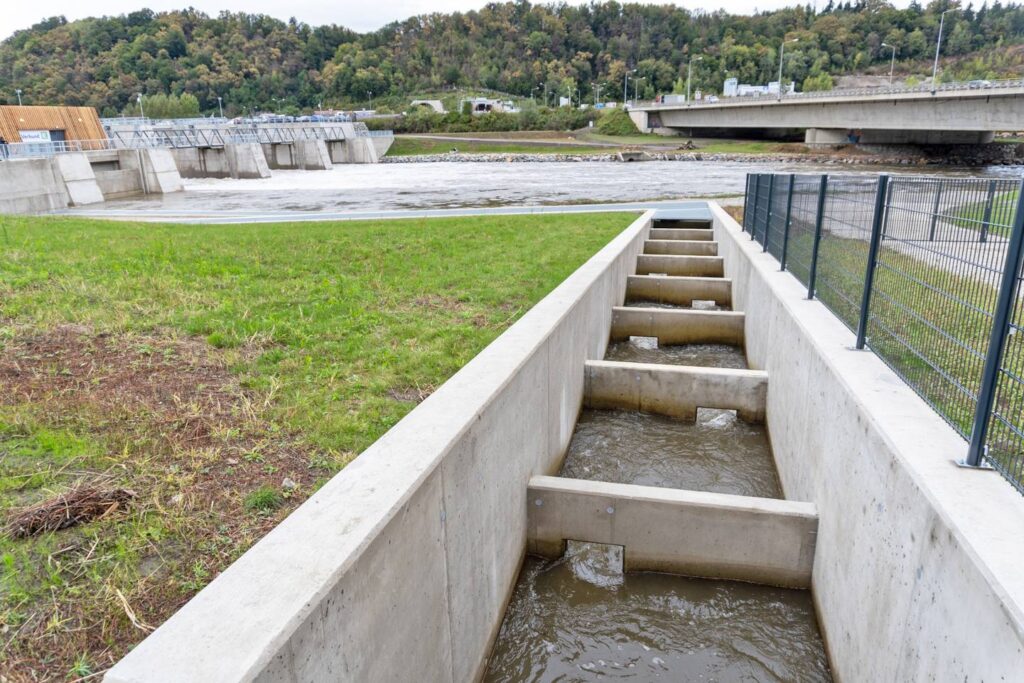
© zek
A milestone for climate protection
After around six months following the start of the trials, the system is now in regular fully-automatic operation. David Oberlerchner offers a thoroughly positive summary of project progress, and the pleasing results: “The power plant has been generating electricity smoothly ever since it was commissioned. Initially, plants of this size and complexity obviously encounter a few teething problems, but these have now been largely eradicated. We can honestly say this project has been, and is, a success. All the companies and people involved deserve major compliments, having distinguished themselves with a cooperative approach and open communication.” There was plenty of praise for the project at the opening ceremony on 4th October, as the plant will generate the power – completely sustainably – to cover the annual electricity requirements of around 15,000 average households. Former Deputy Governor Anton Lang explained how the project made an important contribution to climate protection: “In recent years, in provincial government we have implemented numerous cross-departmental measures for climate protection. A key to achieving this goal is the massive expansion of renewable energy use, so I’m very pleased the Mur power plant in Gratkorn is another milestone along this road.”
